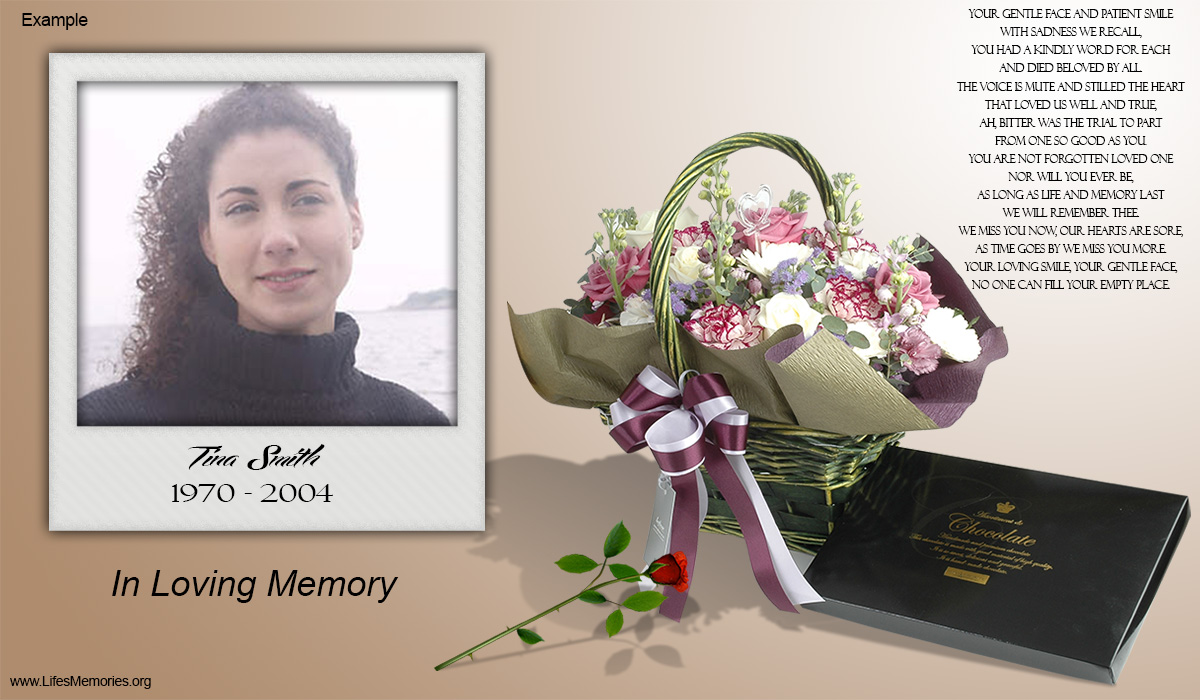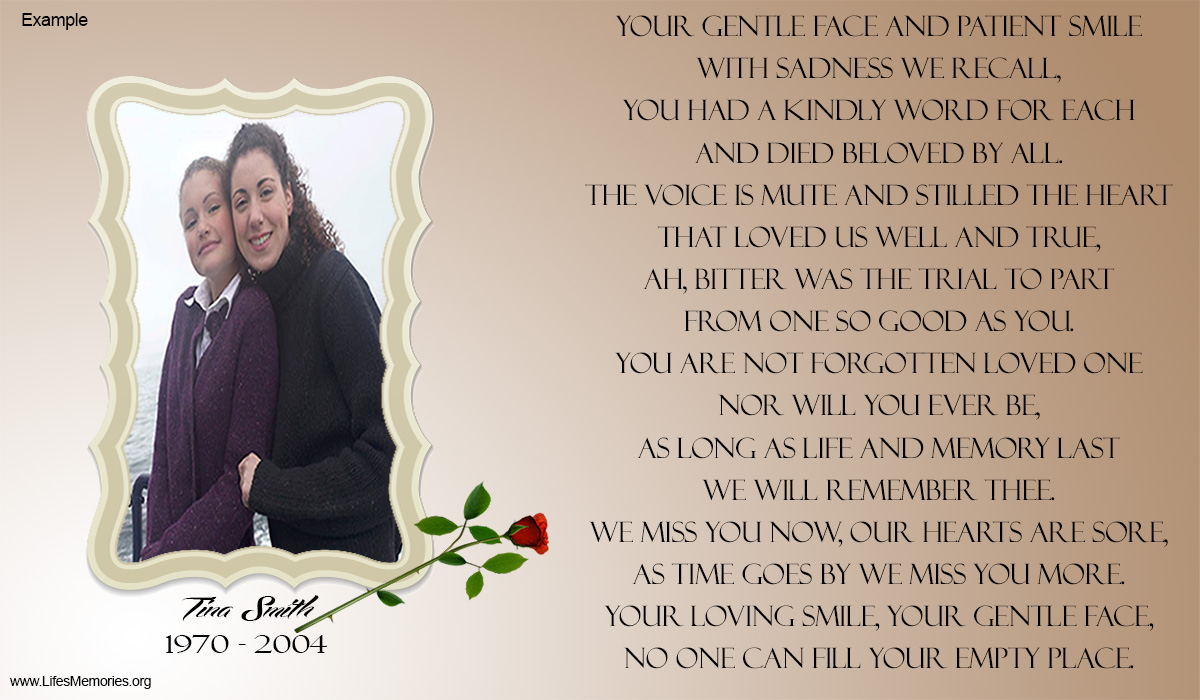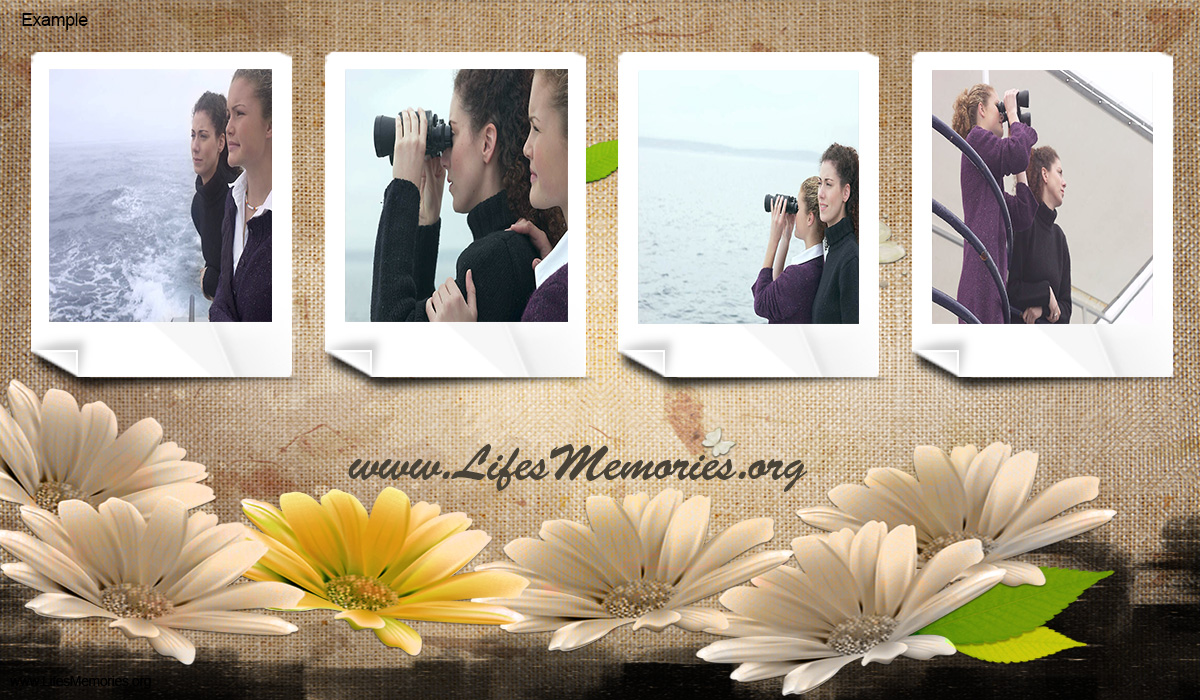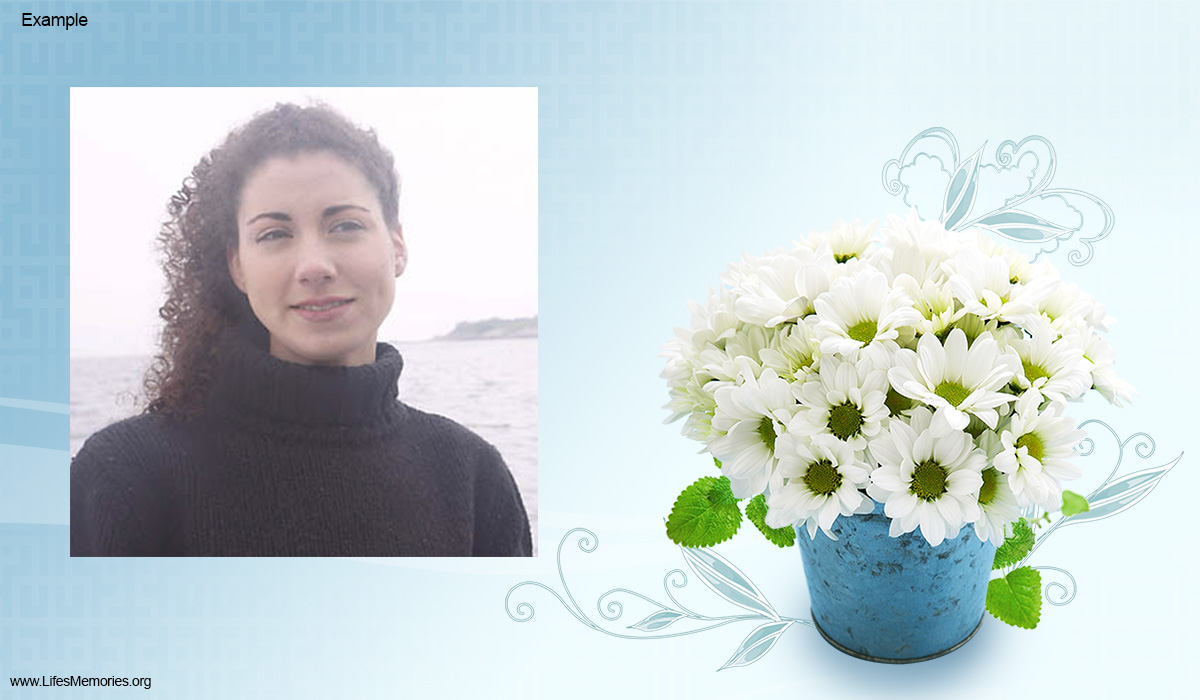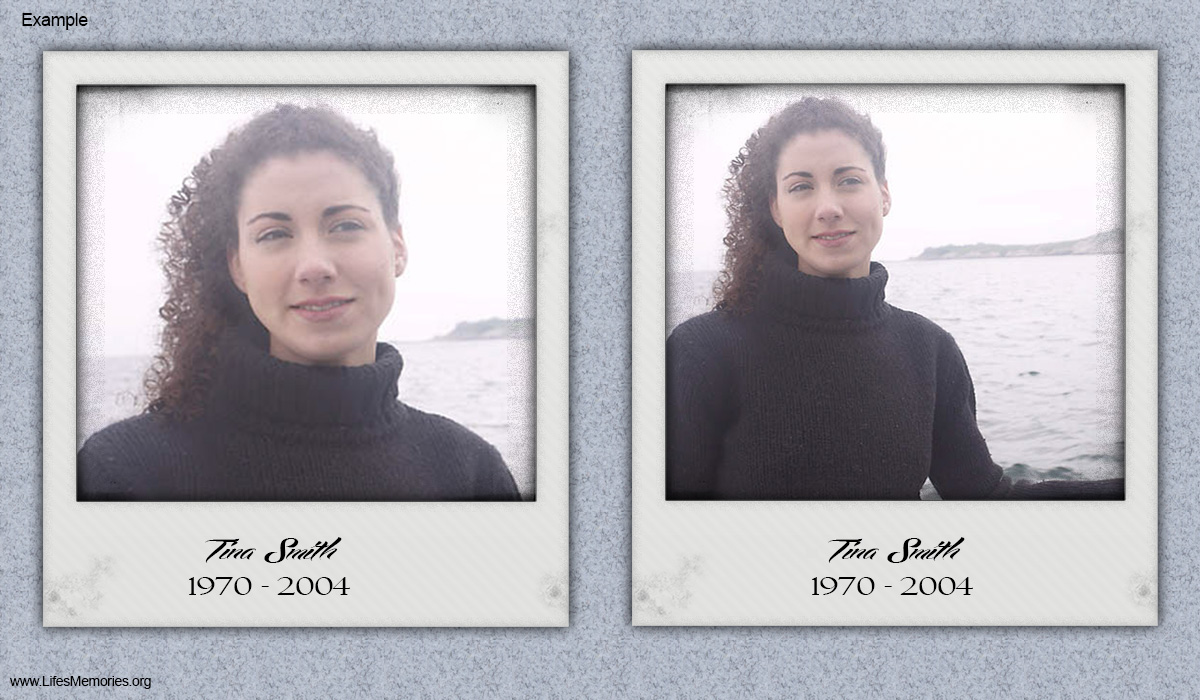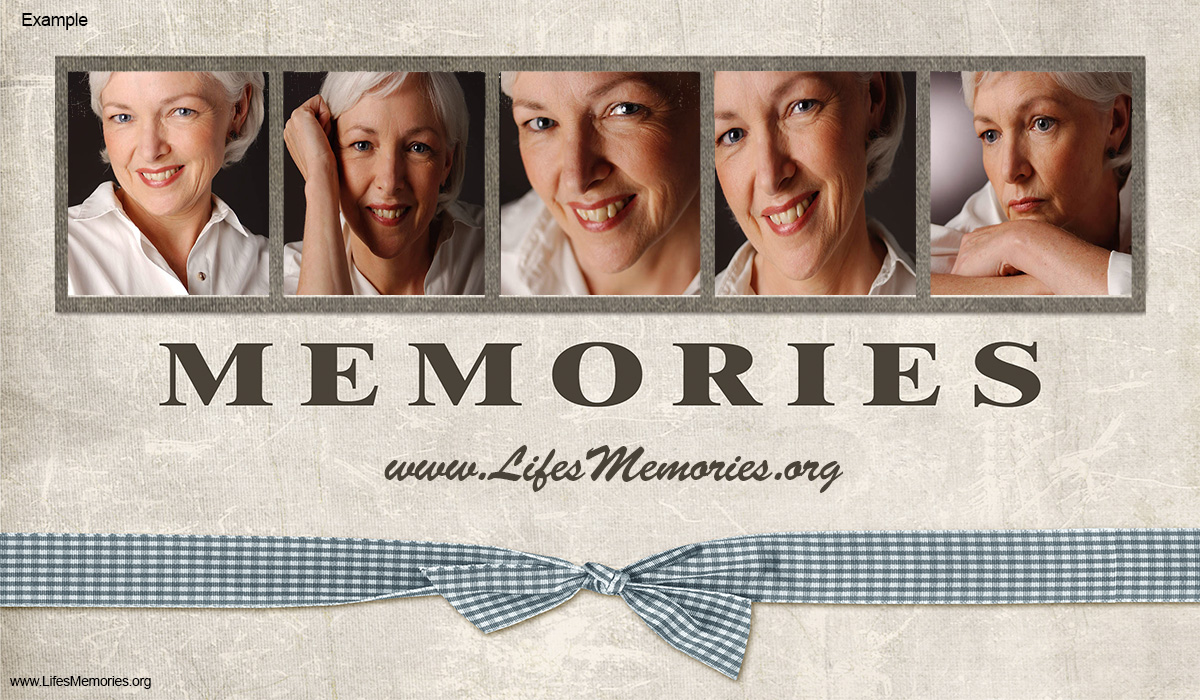LifesMemories.org - Example Photo Montage
Smart TV Compatible

Example Announcement Page
Unlimited Content:
Lucille Désirée Ball Morton (August 6, 1911 – April 26, 1989) was an American actress, comedian, model, film-studio executive, and producer. She was best known as the star of the self-produced sitcoms I Love Lucy, The Lucy–Desi Comedy Hour, The Lucy Show, and Here's Lucy.
Ball's career began in 1929 when she landed work as a model. Shortly thereafter, she began her performing career on Broadway using the stage names Diane Belmont and Dianne Belmont. She later appeared in several minor film roles in the 1930s and 1940s as a contract player for RKO Radio Pictures, being cast as a chorus girl or in similar roles. During this time, she met Cuban bandleader Desi Arnaz, and the two eloped in November 1940. In the 1950s, Ball ventured into television. In 1951, she and Arnaz created the sitcom I Love Lucy, a series that became one of the most beloved programs in television history. The same year, Ball gave birth to their first child, Lucie Arnaz, followed by Desi Arnaz, Jr. in 1953. Ball and Arnaz divorced in May 1960, and she married comedian Gary Morton in 1961.
In 1962, Ball became the first woman to run a major television studio, Desilu Productions, which produced many popular television series, including Mission: Impossible and Star Trek. Ball did not back away from acting completely, appearing in film and television roles for the rest of her career until her death in April 1989 from an abdominal aortic dissection at the age of 77.
Ball was nominated for 13 Primetime Emmy Awards, winning four times. In 1977, Ball was among the first recipients of the Women in Film Crystal Award.
She was the recipient of the Golden Globe Cecil B. DeMille Award in 1979,[10] inducted into the Television Hall of Fame in 1984, the Lifetime Achievement Award from the Kennedy Center Honors in 1986, and the Governors Award from the Academy of Television Arts & Sciences in 1989.
Early life:
Born in Jamestown, New York, Lucille Désirée Ball was the daughter of Henry Durrell Ball (1887–1915) and Désirée "DeDe" Evelyn (née Hunt; 1892–1977). Her family lived in Wyandotte, Michigan for a time. When she was three years old, her 27-year-old father died of typhoid fever. She and her family then moved to nearby Celoron to live with her grandparents. She sometimes later claimed that she had been born in Butte, Montana where her grandparents had lived. A number of magazines reported inaccurately that she had decided that Montana was a more romantic place to be born than New York and repeated a fantasy of a "western childhood". In fact, her father had moved the family to Anaconda, Montana, where they lived briefly, among other places, for work. Her family was Baptist, and her ancestry was mostly English, and included small amounts of Scottish, French, and Irish.
Some of her genealogy leads to the earliest settlers in the colonies, including Elder John Crandall of Westerly, Rhode Island, and Edmund Rice, an early emigrant from England to the Massachusetts Bay Colony.
Her father was a lineman for Bell Telephone Company and was frequently transferred because of his occupation. Within three years of her birth, Lucille had moved with her parents from Jamestown to Anaconda, Montana, and later to Trenton. While DeDe Ball was pregnant with her second child, Frederick, Henry Ball contracted typhoid fever and died in February 1915. Ball recalled little from the day her father died, but remembered a bird getting trapped in the house. From that day forward, she suffered from ornithophobia.
After her father died, her mother returned to New York. Ball and her brother, Fred Henry Ball (1915–2007), were raised by their mother and maternal grandparents in Celoron, New York, a summer resort village on Lake Chautauqua, just 2.5 miles west of downtown Jamestown. Lucy loved Celoron Park, one of the best amusement areas in the United States at that time. Its boardwalk had a ramp to the lake that served as a children's slide, the Pier Ballroom, a roller-coaster, a bandstand, and a stage where vaudeville concerts and regular theatrical shows were presented which made Celoron Park an entertainment destination.
Four years after Henry Ball's death, DeDe Ball married Edward Peterson. While her mother and stepfather looked for work in another city, Lucy's stepfather’s parents cared for her brother and her. Ball's new guardians were a puritanical Swedish couple who banished all mirrors from the house except for one over the bathroom sink. When the young Ball was caught admiring herself in it, she was severely chastised for being vain. This period of time affected Ball so deeply that, in later life, she claimed that it lasted seven or eight years.
Peterson was a Shriner. When his organization needed female entertainers for the chorus line of their next show, he encouraged his 12-year-old stepdaughter to audition. While Ball was onstage, she realized performing was a great way to gain praise and recognition. Her appetite for recognition had thus been awakened at an early age. In 1927, her family suffered misfortune. Their house and furnishings were lost to settle a financial legal judgment after a neighborhood boy was accidentally shot and paralyzed by someone target shooting in their yard under the supervision of Ball's grandfather. The family subsequently moved into a small apartment in Jamestown.
Career:
Teenage years and early career
In 1925, Ball, then only 14, started dating Johnny DeVita, a 21-year-old local hoodlum. DeDe was unhappy with the relationship, but was unable to influence her daughter to end it. She expected the romance to burn out in a few weeks, but that did not happen. After about a year, DeDe tried to separate them by using Lucille's desire to be in show business. Despite the family's meager finances, she arranged for Lucille to go to the John Murray Anderson School for the Dramatic Arts in New York City, where Bette Davis was a fellow student. Ball later said about that time in her life, "All I learned in drama school was how to be frightened." Ball's instructors felt that she would not be successful in the entertainment business, and were not afraid to say this in front of her, a criticism which Ball did not enjoy hearing.
Ball was determined to prove her teachers wrong and returned to New York City in 1928. Among her other jobs, she landed work as a fashion model for Hattie Carnegie. Her career was thriving when she became ill with rheumatoid arthritis, and was unable to work for two years.
She moved back to New York City in 1932 to resume her pursuit of a career as an actress and supported herself by again working for Carnegie and as the Chesterfield cigarette girl. Using the name Diane (sometimes spelled Dianne) Belmont, she started getting some chorus work on Broadway, but the work was not lasting. Ball was hired – but then quickly fired – by theatre impresario Earl Carroll, from his Vanities, and by Florenz Ziegfeld, from a touring company of Rio Rita.
Hollywood:
After an uncredited stint as a Goldwyn Girl in Roman Scandals (1933), starring Eddie Cantor and Gloria Stuart, Ball moved permanently to Hollywood to appear in films. She appeared in many small movie roles in the 1930s as a contract player for RKO Radio Pictures, including a two-reel comedy short with the Three Stooges (Three Little Pigskins, 1934) and a movie with the Marx Brothers (Room Service, 1938). She can also be seen as one of the featured models in the Fred Astaire and Ginger Rogers film Roberta (1935), briefly as the flower girl in Top Hat (1935), and in a brief supporting role at the beginning of Follow the Fleet (1936), another Astaire-Rogers film. Ball and Ginger Rogers, who were distant maternal cousins, played aspiring actresses in the film Stage Door (1937).
In 1936, she landed the role she hoped would lead her to Broadway, in the Bartlett Cormack play Hey Diddle Diddle, a comedy set in a duplex apartment in Hollywood. The play premiered in Princeton, New Jersey, on January 21, 1937, with Ball playing the part of Julie Tucker, "one of three roommates coping with neurotic directors, confused executives, and grasping stars who interfere with the girls' ability to get ahead".
The play received good reviews, but problems existed, chiefly with its star, Conway Tearle, who was in poor health. Cormack wanted to replace him, but the producer, Anne Nichols, said the fault lay with the character and insisted that the part needed to be reshaped and rewritten. The two were unable to agree on a solution. The play was scheduled to open on Broadway at the Vanderbilt Theatre, but closed after one week in Washington, DC, when Tearle suddenly became gravely ill.
Ball once considered and auditioned for the role of Scarlett O'Hara for Gone with the Wind (1939), but Vivien Leigh got the part, winning an Academy Award for Best Actress for her role. She signed with Metro-Goldwyn-Mayer in the 1940s, but never achieved major stardom from her appearance in the studio's films. She was known in many Hollywood circles as "Queen of the B's" – a title previously held by Fay Wray – starring in a number of B-movies, such as Five Came Back (1939). Like many budding actresses, Ball picked up radio work to earn side income, as well as gain exposure. In 1937, she appeared regularly on The Phil Baker Show.
When that completed its run in 1938, Ball joined the cast of The Wonder Show starring Jack Haley (best remembered as the Tin Woodman in The Wizard of Oz, 1939). Here she began her 50-year professional relationship with Gale Gordon, who served as show announcer. The Wonder Show lasted one season, with the final episode airing on April 7, 1939. MGM producer Arthur Freed purchased the Broadway hit musical play DuBarry Was a Lady (1943) especially for Ann Sothern, but when Sothern turned down the part, the choice role was awarded to Ball, who in real life was Sothern's best friend. In 1946, Ball starred in Lover Come Back. In 1947, she appeared in the murder mystery Lured as Sandra Carpenter, a Taxi dancer in London.
I Love Lucy and Desilu
A scene from the I Love Lucy episode "Lucy Goes to Scotland", 1956
With John Wayne in I Love Lucy, 1955
In 1948, Ball was cast as Liz Cugat (later "Cooper"), a wacky wife, in My Favorite Husband, a radio program for CBS Radio.
The program was successful, and CBS asked her to develop it for television. She agreed, but insisted on working with her real-life husband, Cuban bandleader Desi Arnaz. CBS executives were reluctant, thinking the public would not accept an All-American redhead and a Cuban as a couple. CBS was initially not impressed with the pilot episode produced by the couple's Desilu Productions company, so the couple toured the road in a vaudeville act with Lucy as the zany housewife wanting to get in Arnaz's show. The tour was a great success, and CBS put I Love Lucy into their lineup.
I Love Lucy was not only a star vehicle for Lucille Ball, but also a way for her to try to salvage her marriage to Arnaz, which had become badly strained, in part because both had hectic performing schedules which often kept them apart but mostly due to Desi's attraction to other women.
Along the way, she created a television dynasty and reached several "firsts". Ball was the first woman in television to be head of a production company: Desilu, the company that Arnaz and she formed. After their divorce, Ball bought out Arnaz's share of the studio, and she proceeded to function as a very active studio head. Desilu and I Love Lucy pioneered a number of methods still in use in television production today such as filming before a live studio audience with a number of cameras, and distinct sets adjacent to each other. During this time, Ball taught a 32-week comedy workshop at the Brandeis-Bardin Institute. Ball was quoted as saying, "You cannot teach someone comedy; either they have it or they don't."
Ball and Arnaz wanted to remain in their Los Angeles home, but the time zone logistics made that broadcast norm impossible. Prime time in L.A. was too late at night on the East Coast to air a major network series, meaning the majority of the TV audience would be seeing not only the inferior picture of kinescopes, but seeing them at least a day later.
Sponsor Philip Morris did not want to show day-old kinescopes to the major markets on the East Coast, yet neither did they want to pay for the extra cost that filming, processing, and editing would require, pressuring Ball and Arnaz to relocate to New York City. Ball and Arnaz offered to take a pay cut to finance filming, on the condition that their company, Desilu, would retain the rights to that film once it was aired. CBS relinquished the show rights to Desilu after initial broadcast, not realizing they were giving away a valuable and durable asset. In 1957, CBS bought the rights back for $1,000,000 ($8.71 million in today's terms), which provided Ball and Arnaz the down payment for the purchase of the former RKO Pictures studios, which became Desilu Studios.
I Love Lucy dominated the ratings in the United States for most of its run. (An attempt was made to adapt the show for radio; the cast and writers adapted the memorable "Breaking the Lease" episode – in which the Ricardos and Mertzes fall out over an argument, the Ricardos threaten to move, but they are stuck in a firm lease – for a radio audition disc that never aired, but has survived.)
A scene in which Lucy and Ricky practice the tango, in the episode "Lucy Does The Tango", evoked the longest recorded studio audience laugh in the history of the show; it was so long, the sound editor had to cut that particular part of the soundtrack in half. During the show's production breaks, Lucy and Desi starred together in two feature films: The Long, Long Trailer (1954) and Forever, Darling (1956). After I Love Lucy ended its run in 1957, the main cast continued to appear in occasional hour-long specials under the title The Lucy–Desi Comedy Hour until 1960.
Desilu produced several other popular shows, such as The Untouchables, Star Trek, and Mission: Impossible. The studio was eventually sold for $17,000,000 ($125 million in today's terms) and merged into Paramount Pictures in 1967.
Later career
The 1960 Broadway musical Wildcat ended its run early when Ball became too ill to continue in the show. The show was the source of the song she made famous, "Hey, Look Me Over", which she performed with Paula Stewart on The Ed Sullivan Show. Ball hosted a CBS Radio talk show entitled Let's Talk to Lucy in 1964–65. She also made a few more movies including Yours, Mine, and Ours (1968), and the musical Mame (1974), and two more successful long-running sitcoms for CBS: The Lucy Show (1962–68), which costarred Vivian Vance and Gale Gordon, and Here's Lucy (1968–74), which also featured Gordon, as well as Lucy's real-life children, Lucie Arnaz and Desi Arnaz, Jr. She appeared on the Dick Cavett show in 1974 and spoke of her history and life with Arnaz. She revealed how she felt about other actors and actresses, as well as her love for Arnaz.
Ball's close friends in the business included perennial co-star Vivian Vance and film stars Judy Garland, Ann Sothern, and Ginger Rogers, and comedic television performers Mary Wickes and Mary Jane Croft; all except Garland appeared at least once on her various series. Former Broadway co-stars Andes and Stewart also appeared at least once on her later sitcoms. Ball mentored actress and singer Carole Cook, and befriended Barbara Eden, when Eden appeared on an episode of I Love Lucy.
In 1966, Ball became a friend and mentor to Carol Burnett. After having guested on Burnett's highly successful CBS-TV special Carol + 2 and having the younger performer reciprocate by appearing on The Lucy Show, Ball reportedly offered Burnett her own sitcom called Here's Agnes, to be produced by Desilu Productions. Burnett declined the offer, not wanting to commit herself to a weekly series. The two remained close friends until Ball's death in 1989. Ball sent flowers every year on Burnett's birthday. When Burnett awoke on the day of her 56th birthday in 1989, she discovered via the morning news that Lucille Ball had died. Later that afternoon, flowers arrived at Burnett's house with a note reading, "Happy Birthday, Kid. Love, Lucy."
Ball was originally considered by Frank Sinatra for the role of Mrs. Iselin in the Cold War thriller The Manchurian Candidate. Director/producer John Frankenheimer, however, had worked with Angela Lansbury in a mother role in All Fall Down and insisted on having her for the part.
An aged Ball standing in a crowd of celebrities, wearing a black and gold sequinned dress with her characteristic red hair, looking fragile.
Ball at her last public appearance at the 61st Academy Awards in 1989, four weeks before her death: Ball's husband Gary Morton can be seen on the left side of the photograph.
During the mid-1980s, Ball attempted to resurrect her television career. In 1982, she hosted a two-part Three's Company retrospective, showing clips from the show's first five seasons, summarizing memorable plotlines, and commenting on her love of the show.
A 1985 dramatic made-for-TV film about an elderly homeless woman, Stone Pillow, received mixed reviews. Her 1986 sitcom comeback Life with Lucy, costarring her longtime foil Gale Gordon and co-produced by Ball, Gary Morton, and prolific producer/former actor Aaron Spelling was cancelled less than two months into its run by ABC. In February 1988, Ball was named the Hasty Pudding Woman of the Year.
In May 1988, Ball was hospitalized after suffering a mild heart attack. Her last public appearance, just one month before her death, was at the 1989 Academy Awards telecast in which she and fellow presenter Bob Hope were given a standing ovation.
Testimony before the House Committee on Un-American Activities
When Ball registered to vote in 1936, she listed her party affiliation as Communist. (She was registered as a Communist in 1938 as well.)
To sponsor the Communist Party's 1936 candidate for the California State Assembly's 57th District, Ball signed a certificate stating, "I am registered as affiliated with the Communist Party." The same year, she was appointed to the State Central Committee of the Communist Party of California, according to records of the California Secretary of State. In 1937, Hollywood writer Rena Vale, a self-identified former Communist, attended a Communist Party new members' class at Ball's home, according to Vale's testimony before the United States House of Representatives' Special House Un-American Activities Committee (HUAC), on July 22, 1940. Two years later, Vale affirmed this testimony in a sworn deposition:
Within a few days after my third application to join the Communist Party was made, I received a notice to attend a meeting on North Ogden Drive, Hollywood; although it was a typed, unsigned note, merely requesting my presence at the address at 8 o'clock in the evening on a given day, I knew it was the long-awaited notice to attend Communist Party new members classes ... on arrival at this address I found several others present; an elderly man informed us that we were the guests of the screen actress, Lucille Ball, and showed us various pictures, books and other objects to establish that fact, and stated she was glad to loan her home for a Communist Party new members class.
— Affidavit of Rena M. Vale, November 23, 1942. Joint Fact-Finding Committee on Un-American Activities in California.
In a 1944 British Pathé newsreel, titled Fund Raising for Roosevelt, Ball was featured prominently among several stage and film stars at events in support of President Franklin D. Roosevelt's fundraising campaign for the March of Dimes. She stated that in the 1952 US Presidential Election, she voted for Republican Dwight Eisenhower.
On September 4, 1953, Ball met privately with HUAC investigator William A. Wheeler in Hollywood and gave him sealed testimony. She stated that she had registered to vote as a Communist "or intended to vote the Communist Party ticket" in 1936 at her socialist grandfather's insistence. She stated she "at no time intended to vote as a Communist",
Ball stated she has never been a member of the Communist Party "to her knowledge" ... [She] did not know whether or not any meetings were ever held at her home at 1344 North Ogden Drive; stated... [that if she had been appointed] as a delegate to the State Central Committee of the Communist Party of California in 1936 it was done without her knowledge or consent; [and stated that she] did not recall signing the document sponsoring EMIL FREED for the Communist Party nomination to the office of member of the assembly for the 57th District ... A review of the subject's file reflects no activity that would warrant her inclusion on the Security Index.
Immediately before the filming of episode 68 ("The Girls Go Into Business") of I Love Lucy, Desi Arnaz, instead of his usual audience warm-up, told the audience about Lucy and her grandfather. Reusing the line he had first given to Hedda Hopper in an interview, he quipped: "The only thing red about Lucy is her hair, and even that is not legitimate."
Personal life:
Engagement
Her engagement to actor Broderick Crawford was announced in June 1936. It was reported in the Los Angeles Times that they were introduced through Crawford's mother, actress Helen Crawford. Decades later, she and Crawford were scheduled to appear on the Tonight Show with Johnny Carson.
Marriage, children, and divorce
In 1940, Ball met Cuban-born bandleader Desi Arnaz while filming the Rodgers and Hart stage hit Too Many Girls. When they met again on the second day, the two connected immediately and eloped the same year. Although Arnaz was drafted into the Army in 1942, he ended up being classified for limited service due to a knee injury. As a result, Arnaz stayed in Los Angeles, organizing and performing USO shows for wounded GIs being brought back from the Pacific.
Ball filed for divorce in 1944, going so far as obtaining an interlocutory decree; however, she and Arnaz reconciled, which precluded the entry of a final decree.
Colored glamorous shot of Lucille Ball and Arnaz standing. Both are smiling to the front. Ball at the left wears a ceremonial gown; Arnaz at right wears a tuxedo.
Ball with husband Desi Arnaz in 1950s
On July 17, 1951, one month before her 40th birthday, Ball gave birth to daughter Lucie Désirée Arnaz. A year and a half later, Ball gave birth to her second child, Desiderio Alberto Arnaz IV, known as Desi Arnaz, Jr. Before he was born, I Love Lucy was a solid ratings hit, and Ball and Arnaz wrote the pregnancy into the show. (Ball's necessary and planned caesarean section in real life was scheduled for the same date that her television character gave birth.)
Several demands were made by CBS, insisting that a pregnant woman could not be shown on television, nor could the word "pregnant" be spoken on-air. After approval from several religious figures the network allowed the pregnancy storyline, but insisted that the word "expecting" be used instead of "pregnant". (Arnaz garnered laughs when he deliberately mispronounced it as "'spectin'".)The episode's official title was "Lucy Is Enceinte", borrowing the French word for pregnant; however, episode titles never appeared on the show.
The episode aired on the evening of January 19, 1953, with 44 million viewers watching Lucy Ricardo welcome little Ricky, while in real life Ball delivered her second child, Desi Jr., that same day in Los Angeles. The birth made the cover of the first issue of TV Guide for the week of April 3–9, 1953.[citation needed]
In October 1956, Ball, Arnaz, Vance, and William Frawley all appeared on a Bob Hope special on NBC, including a spoof of I Love Lucy, the only time all four stars were together on a color telecast. By the end of the 1950s, Desilu had become a large company, causing a good deal of stress for both Ball and Arnaz.
On March 3, 1960, a day after Desi's 43rd birthday (and one day after the filming of Lucy and Desi's last episode together), Ball filed papers in Santa Monica Superior Court, claiming married life with Desi was "a nightmare" and nothing at all as it appeared on I Love Lucy.
On May 4, 1960, just two months after filming that episode (the final episode of The Lucy-Desi Comedy Hour), the couple divorced. Until his death in 1986, however, Arnaz and Ball remained friends and often spoke very fondly of each other. Her real-life divorce indirectly found its way into her later television series, as she was always cast as an unmarried woman.
The following year, Ball starred in the Broadway musical Wildcat, which co-starred Keith Andes and Paula Stewart. It marked the beginning of a 30-year friendship between Lucy and Stewart, who introduced Lucy to second husband, Gary Morton, a Borscht Belt comic who was 13 years her junior.[5] According to Ball, Morton claimed he had never seen an episode of I Love Lucy due to his hectic work schedule. Ball immediately installed Morton in her production company, teaching him the television business and eventually promoting him to producer. Morton played occasional bit parts on Ball's various series.
Ball was outspoken against the relationship her son had with actress Patty Duke. Later, commenting on when her son dated Liza Minnelli, she was quoted as saying, "I miss Liza, but you cannot domesticate Liza."
Illness and death
On April 18, 1989, Ball was at her home in Beverly Hills when she complained of chest pains. An ambulance was called and she was rushed to the emergency room of Cedars-Sinai Medical Center. She was diagnosed with dissecting aortic aneurysm and underwent heart surgery for nearly eight hours, including the transplant of a new aorta. The surgery appeared to have been successful, and Ball began recovering very quickly, even walking around her room with little assistance. She received a flurry of get-well wishes from Hollywood, and across the street from Cedars-Sinai Medical Center, the Hard Rock Café erected a sign reading "Hard Rock Loves Lucy". However, shortly after dawn on April 26, Ball awoke with severe back pains and soon lost consciousness.
Attempts to revive her proved unsuccessful and she died at 5:47 a.m. PDT. Doctors determined that Ball, who was 77 years old, had succumbed to a second aortic rupture, this time in the abdominal area, and that it was not directly related to her surgery the previous week.
Her body was cremated and the ashes were initially interred in Forest Lawn – Hollywood Hills Cemetery in Los Angeles. However, in 2002, her children moved her remains to the Hunt family plot at Lake View Cemetery in Jamestown, New York, where her parents, Henry and Desirée (Hunt) Ball, and her grandparents are buried.
Recognition and legacy
The Lucille Ball Little Theatre in Ball's hometown of Jamestown, New York
On February 8, 1960, Ball was awarded two stars on the Hollywood Walk of Fame: one at 6436 Hollywood Boulevard for contributions to motion pictures, and one at 6100 Hollywood Boulevard for television.
Ball received many prestigious awards throughout her career, including some posthumously such as the Presidential Medal of Freedom by President George H. W. Bush on July 6, 1989,[82] and The Women's International Center's 'Living Legacy Award'.
A Lucille Ball-Desi Arnaz Center museum is in Lucy's hometown of Jamestown, New York. The Little Theatre was renamed the Lucille Ball Little Theatre in her honor. Ball was among Time magazine's "100 Most Important People of the Century".
On June 7, 1990, Universal Studios Florida opened a walk-through attraction dedicated to Ball, Lucy - A Tribute, which featured clips of shows, as well as various pieces of trivia about her, along with items owned by or associated with Lucille, and an interactive quiz for guests. The attraction was permanently closed on August 17, 2015.
On August 6, 2001, which would have been her 90th birthday, the United States Postal Service honored her with a commemorative postage stamp as part of its Legends of Hollywood series. Ball appeared on the cover of TV Guide more than any other person; she appeared on 39 covers, including the first cover in 1953 with her baby son, Desi Arnaz, Jr. TV Guide voted Lucille Ball as the 'Greatest TV Star of All Time' and it later commemorated the 50th anniversary of I Love Lucy with eight collector covers celebrating memorable scenes from the show. In another instance it named I Love Lucy the second-best television program in American history, after Seinfeld.
Due to her support for the Women's Movement, Ball was inducted into the National Women's Hall of Fame in 2001.
Source: Wikipedia, the free encyclopedia



